Cong Xu
MARS2 2025 Challenge on Multimodal Reasoning: Datasets, Methods, Results, Discussion, and Outlook
Sep 17, 2025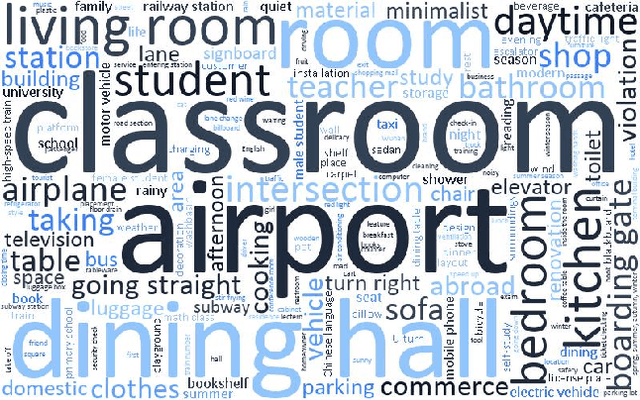
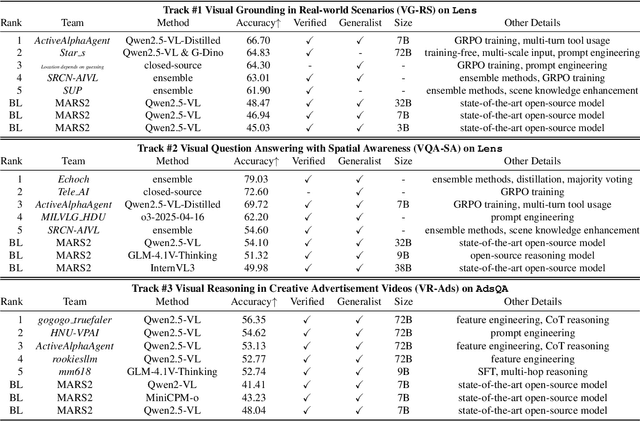
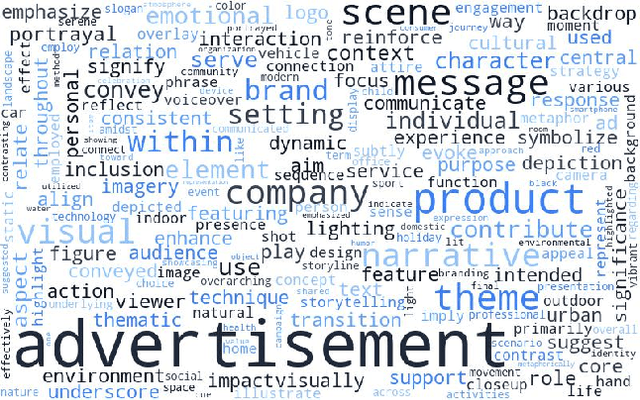

Abstract:This paper reviews the MARS2 2025 Challenge on Multimodal Reasoning. We aim to bring together different approaches in multimodal machine learning and LLMs via a large benchmark. We hope it better allows researchers to follow the state-of-the-art in this very dynamic area. Meanwhile, a growing number of testbeds have boosted the evolution of general-purpose large language models. Thus, this year's MARS2 focuses on real-world and specialized scenarios to broaden the multimodal reasoning applications of MLLMs. Our organizing team released two tailored datasets Lens and AdsQA as test sets, which support general reasoning in 12 daily scenarios and domain-specific reasoning in advertisement videos, respectively. We evaluated 40+ baselines that include both generalist MLLMs and task-specific models, and opened up three competition tracks, i.e., Visual Grounding in Real-world Scenarios (VG-RS), Visual Question Answering with Spatial Awareness (VQA-SA), and Visual Reasoning in Creative Advertisement Videos (VR-Ads). Finally, 76 teams from the renowned academic and industrial institutions have registered and 40+ valid submissions (out of 1200+) have been included in our ranking lists. Our datasets, code sets (40+ baselines and 15+ participants' methods), and rankings are publicly available on the MARS2 workshop website and our GitHub organization page https://github.com/mars2workshop/, where our updates and announcements of upcoming events will be continuously provided.
Beyond Semantic Understanding: Preserving Collaborative Frequency Components in LLM-based Recommendation
Aug 14, 2025Abstract:Recommender systems in concert with Large Language Models (LLMs) present promising avenues for generating semantically-informed recommendations. However, LLM-based recommenders exhibit a tendency to overemphasize semantic correlations within users' interaction history. When taking pretrained collaborative ID embeddings as input, LLM-based recommenders progressively weaken the inherent collaborative signals as the embeddings propagate through LLM backbones layer by layer, as opposed to traditional Transformer-based sequential models in which collaborative signals are typically preserved or even enhanced for state-of-the-art performance. To address this limitation, we introduce FreLLM4Rec, an approach designed to balance semantic and collaborative information from a spectral perspective. Item embeddings that incorporate both semantic and collaborative information are first purified using a Global Graph Low-Pass Filter (G-LPF) to preliminarily remove irrelevant high-frequency noise. Temporal Frequency Modulation (TFM) then actively preserves collaborative signal layer by layer. Note that the collaborative preservation capability of TFM is theoretically guaranteed by establishing a connection between the optimal but hard-to-implement local graph fourier filters and the suboptimal yet computationally efficient frequency-domain filters. Extensive experiments on four benchmark datasets demonstrate that FreLLM4Rec successfully mitigates collaborative signal attenuation and achieves competitive performance, with improvements of up to 8.00\% in NDCG@10 over the best baseline. Our findings provide insights into how LLMs process collaborative information and offer a principled approach for improving LLM-based recommendation systems.
Pushing the Limits of Low-Bit Optimizers: A Focus on EMA Dynamics
May 01, 2025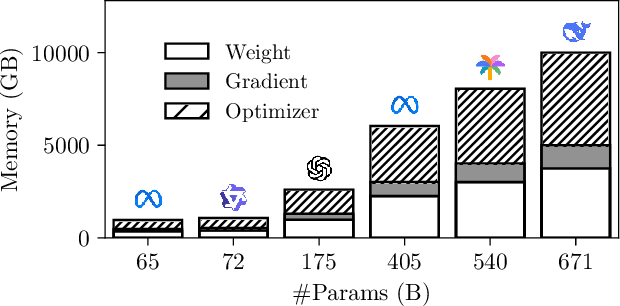
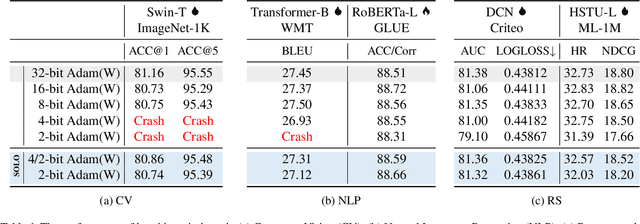
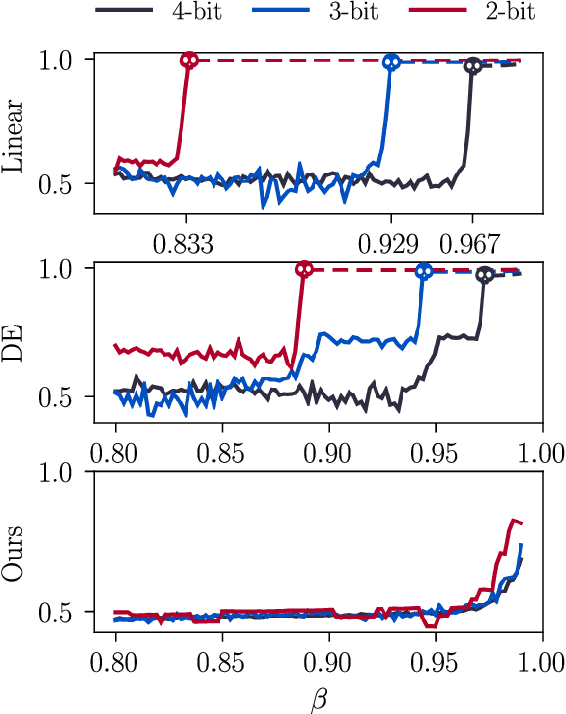
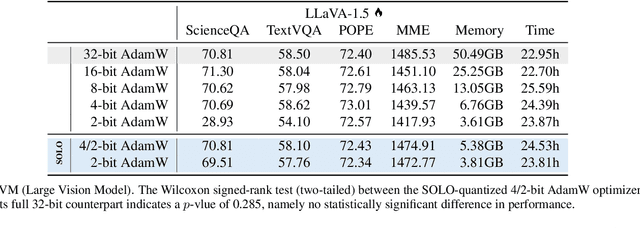
Abstract:The explosion in model sizes leads to continued growth in prohibitive training/fine-tuning costs, particularly for stateful optimizers which maintain auxiliary information of even 2x the model size to achieve optimal convergence. We therefore present in this work a novel type of optimizer that carries with extremely lightweight state overloads, achieved through ultra-low-precision quantization. While previous efforts have achieved certain success with 8-bit or 4-bit quantization, our approach enables optimizers to operate at precision as low as 3 bits, or even 2 bits per state element. This is accomplished by identifying and addressing two critical challenges: the signal swamping problem in unsigned quantization that results in unchanged state dynamics, and the rapidly increased gradient variance in signed quantization that leads to incorrect descent directions. The theoretical analysis suggests a tailored logarithmic quantization for the former and a precision-specific momentum value for the latter. Consequently, the proposed SOLO achieves substantial memory savings (approximately 45 GB when training a 7B model) with minimal accuracy loss. We hope that SOLO can contribute to overcoming the bottleneck in computational resources, thereby promoting greater accessibility in fundamental research.
DropletVideo: A Dataset and Approach to Explore Integral Spatio-Temporal Consistent Video Generation
Mar 08, 2025Abstract:Spatio-temporal consistency is a critical research topic in video generation. A qualified generated video segment must ensure plot plausibility and coherence while maintaining visual consistency of objects and scenes across varying viewpoints. Prior research, especially in open-source projects, primarily focuses on either temporal or spatial consistency, or their basic combination, such as appending a description of a camera movement after a prompt without constraining the outcomes of this movement. However, camera movement may introduce new objects to the scene or eliminate existing ones, thereby overlaying and affecting the preceding narrative. Especially in videos with numerous camera movements, the interplay between multiple plots becomes increasingly complex. This paper introduces and examines integral spatio-temporal consistency, considering the synergy between plot progression and camera techniques, and the long-term impact of prior content on subsequent generation. Our research encompasses dataset construction through to the development of the model. Initially, we constructed a DropletVideo-10M dataset, which comprises 10 million videos featuring dynamic camera motion and object actions. Each video is annotated with an average caption of 206 words, detailing various camera movements and plot developments. Following this, we developed and trained the DropletVideo model, which excels in preserving spatio-temporal coherence during video generation. The DropletVideo dataset and model are accessible at https://dropletx.github.io.
Collaborative Filtering Meets Spectrum Shift: Connecting User-Item Interaction with Graph-Structured Side Information
Feb 12, 2025



Abstract:Graph Neural Network (GNN) has demonstrated their superiority in collaborative filtering, where the user-item (U-I) interaction bipartite graph serves as the fundamental data format. However, when graph-structured side information (e.g., multimodal similarity graphs or social networks) is integrated into the U-I bipartite graph, existing graph collaborative filtering methods fall short of achieving satisfactory performance. We quantitatively analyze this problem from a spectral perspective. Recall that a bipartite graph possesses a full spectrum within the range of [-1, 1], with the highest frequency exactly achievable at -1 and the lowest frequency at 1; however, we observe as more side information is incorporated, the highest frequency of the augmented adjacency matrix progressively shifts rightward. This spectrum shift phenomenon has caused previous approaches built for the full spectrum [-1, 1] to assign mismatched importance to different frequencies. To this end, we propose Spectrum Shift Correction (dubbed SSC), incorporating shifting and scaling factors to enable spectral GNNs to adapt to the shifted spectrum. Unlike previous paradigms of leveraging side information, which necessitate tailored designs for diverse data types, SSC directly connects traditional graph collaborative filtering with any graph-structured side information. Experiments on social and multimodal recommendation demonstrate the effectiveness of SSC, achieving relative improvements of up to 23% without incurring any additional computational overhead.
STAIR: Manipulating Collaborative and Multimodal Information for E-Commerce Recommendation
Dec 16, 2024



Abstract:While the mining of modalities is the focus of most multimodal recommendation methods, we believe that how to fully utilize both collaborative and multimodal information is pivotal in e-commerce scenarios where, as clarified in this work, the user behaviors are rarely determined entirely by multimodal features. In order to combine the two distinct types of information, some additional challenges are encountered: 1) Modality erasure: Vanilla graph convolution, which proves rather useful in collaborative filtering, however erases multimodal information; 2) Modality forgetting: Multimodal information tends to be gradually forgotten as the recommendation loss essentially facilitates the learning of collaborative information. To this end, we propose a novel approach named STAIR, which employs a novel STepwise grAph convolution to enable a co-existence of collaborative and multimodal Information in e-commerce Recommendation. Besides, it starts with the raw multimodal features as an initialization, and the forgetting problem can be significantly alleviated through constrained embedding updates. As a result, STAIR achieves state-of-the-art recommendation performance on three public e-commerce datasets with minimal computational and memory costs. Our code is available at https://github.com/yhhe2004/STAIR.
CAdam: Confidence-Based Optimization for Online Learning
Nov 29, 2024Abstract:Modern recommendation systems frequently employ online learning to dynamically update their models with freshly collected data. The most commonly used optimizer for updating neural networks in these contexts is the Adam optimizer, which integrates momentum ($m_t$) and adaptive learning rate ($v_t$). However, the volatile nature of online learning data, characterized by its frequent distribution shifts and presence of noises, poses significant challenges to Adam's standard optimization process: (1) Adam may use outdated momentum and the average of squared gradients, resulting in slower adaptation to distribution changes, and (2) Adam's performance is adversely affected by data noise. To mitigate these issues, we introduce CAdam, a confidence-based optimization strategy that assesses the consistence between the momentum and the gradient for each parameter dimension before deciding on updates. If momentum and gradient are in sync, CAdam proceeds with parameter updates according to Adam's original formulation; if not, it temporarily withholds updates and monitors potential shifts in data distribution in subsequent iterations. This method allows CAdam to distinguish between the true distributional shifts and mere noise, and adapt more quickly to new data distributions. Our experiments with both synthetic and real-world datasets demonstrate that CAdam surpasses other well-known optimizers, including the original Adam, in efficiency and noise robustness. Furthermore, in large-scale A/B testing within a live recommendation system, CAdam significantly enhances model performance compared to Adam, leading to substantial increases in the system's gross merchandise volume (GMV).
An Enhanced-State Reinforcement Learning Algorithm for Multi-Task Fusion in Large-Scale Recommender Systems
Sep 18, 2024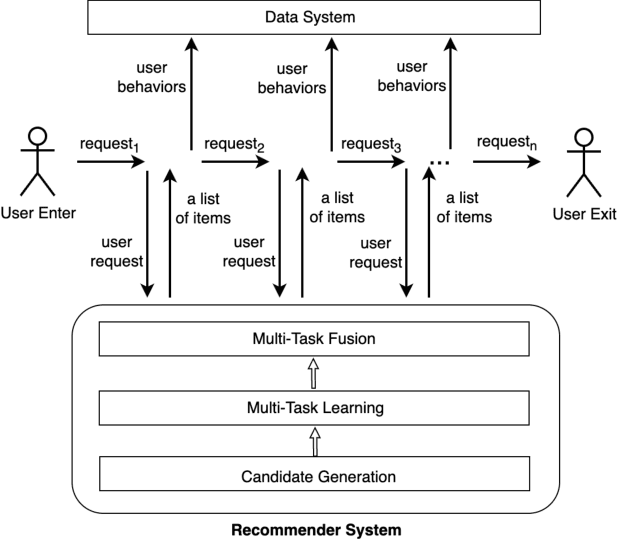
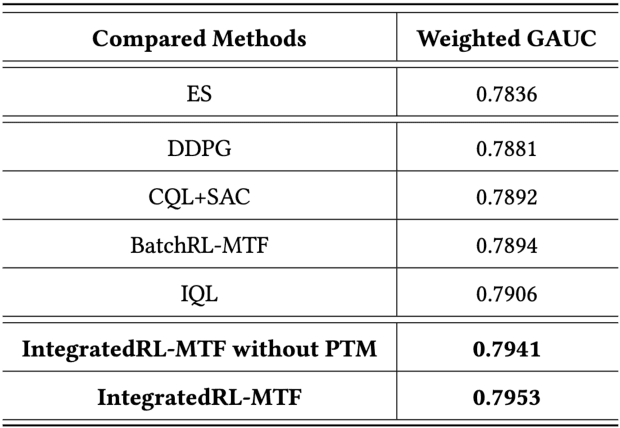
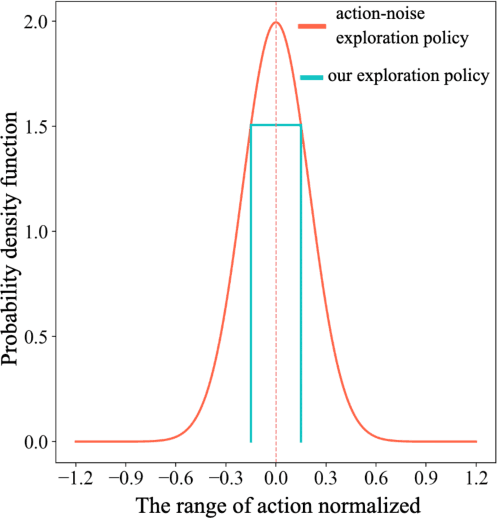
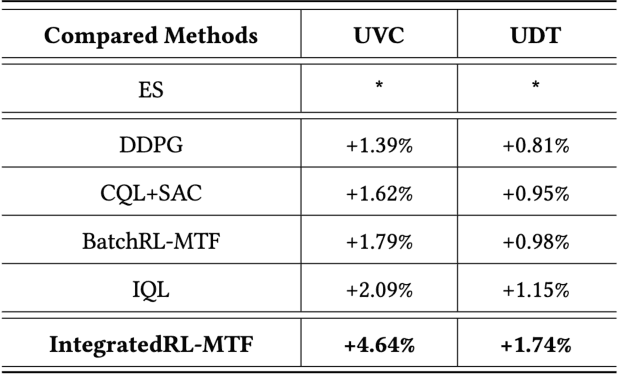
Abstract:As the last key stage of Recommender Systems (RSs), Multi-Task Fusion (MTF) is in charge of combining multiple scores predicted by Multi-Task Learning (MTL) into a final score to maximize user satisfaction, which decides the ultimate recommendation results. In recent years, to maximize long-term user satisfaction within a recommendation session, Reinforcement Learning (RL) is widely used for MTF in large-scale RSs. However, limited by their modeling pattern, all the current RL-MTF methods can only utilize user features as the state to generate actions for each user, but unable to make use of item features and other valuable features, which leads to suboptimal results. Addressing this problem is a challenge that requires breaking through the current modeling pattern of RL-MTF. To solve this problem, we propose a novel method called Enhanced-State RL for MTF in RSs. Unlike the existing methods mentioned above, our method first defines user features, item features, and other valuable features collectively as the enhanced state; then proposes a novel actor and critic learning process to utilize the enhanced state to make much better action for each user-item pair. To the best of our knowledge, this novel modeling pattern is being proposed for the first time in the field of RL-MTF. We conduct extensive offline and online experiments in a large-scale RS. The results demonstrate that our model outperforms other models significantly. Enhanced-State RL has been fully deployed in our RS more than half a year, improving +3.84% user valid consumption and +0.58% user duration time compared to baseline.
Are LLM-based Recommenders Already the Best? Simple Scaled Cross-entropy Unleashes the Potential of Traditional Sequential Recommenders
Aug 26, 2024
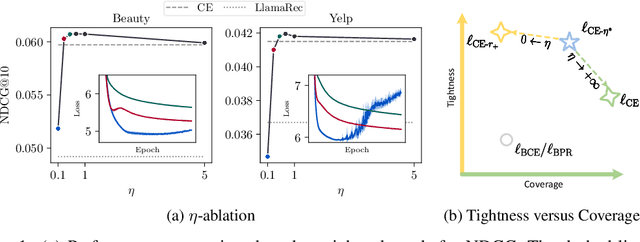


Abstract:Large language models (LLMs) have been garnering increasing attention in the recommendation community. Some studies have observed that LLMs, when fine-tuned by the cross-entropy (CE) loss with a full softmax, could achieve `state-of-the-art' performance in sequential recommendation. However, most of the baselines used for comparison are trained using a pointwise/pairwise loss function. This inconsistent experimental setting leads to the underestimation of traditional methods and further fosters over-confidence in the ranking capability of LLMs. In this study, we provide theoretical justification for the superiority of the cross-entropy loss by demonstrating its two desirable properties: tightness and coverage. Furthermore, this study sheds light on additional novel insights: 1) Taking into account only the recommendation performance, CE is not yet optimal as it is not a quite tight bound in terms of some ranking metrics. 2) In scenarios that full softmax cannot be performed, an effective alternative is to scale up the sampled normalizing term. These findings then help unleash the potential of traditional recommendation models, allowing them to surpass LLM-based counterparts. Given the substantial computational burden, existing LLM-based methods are not as effective as claimed for sequential recommendation. We hope that these theoretical understandings in conjunction with the empirical results will facilitate an objective evaluation of LLM-based recommendation in the future.
Data Efficient Evaluation of Large Language Models and Text-to-Image Models via Adaptive Sampling
Jun 21, 2024Abstract:Evaluating LLMs and text-to-image models is a computationally intensive task often overlooked. Efficient evaluation is crucial for understanding the diverse capabilities of these models and enabling comparisons across a growing number of new models and benchmarks. To address this, we introduce SubLIME, a data-efficient evaluation framework that employs adaptive sampling techniques, such as clustering and quality-based methods, to create representative subsets of benchmarks. Our approach ensures statistically aligned model rankings compared to full datasets, evidenced by high Pearson correlation coefficients. Empirical analysis across six NLP benchmarks reveals that: (1) quality-based sampling consistently achieves strong correlations (0.85 to 0.95) with full datasets at a 10\% sampling rate such as Quality SE and Quality CPD (2) clustering methods excel in specific benchmarks such as MMLU (3) no single method universally outperforms others across all metrics. Extending this framework, we leverage the HEIM leaderboard to cover 25 text-to-image models on 17 different benchmarks. SubLIME dynamically selects the optimal technique for each benchmark, significantly reducing evaluation costs while preserving ranking integrity and score distribution. Notably, a minimal sampling rate of 1% proves effective for benchmarks like MMLU. Additionally, we demonstrate that employing difficulty-based sampling to target more challenging benchmark segments enhances model differentiation with broader score distributions. We also combine semantic search, tool use, and GPT-4 review to identify redundancy across benchmarks within specific LLM categories, such as coding benchmarks. This allows us to further reduce the number of samples needed to maintain targeted rank preservation. Overall, SubLIME offers a versatile and cost-effective solution for the robust evaluation of LLMs and text-to-image models.
 Add to Chrome
Add to Chrome Add to Firefox
Add to Firefox Add to Edge
Add to Edge